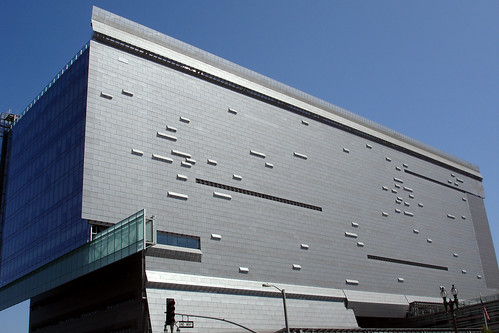
Caltrans Ama 3
Civic Center is marked by City Hall’s magnificent white pillar and is the seat of the city and county government. Various state and federal agencies occupy the space of this center. It is bounded east and west by San Pedro and Figueroa Street, respectively, and in the south and north by First Street and the Hollywood Freeway, respectively. This district is not particularly touristy, and has only a few cultural and architectural sights. Often, you’ll see the scene of homeless people wandering through the Spartan-like architecture found in this area of downtown.[1]
Attractions
City Hall
The highlight and pride of the Civic Center is City Hall at 200 N. Spring Street. It is known famously as the Daily Planet office in the original Superman movies of the 1970s and 80s. The building employs a mosaic of different architectural styles. It has a classical temple base, on which a sleek modern tower is built, and it is crowned by a miniature replica of the Mausoleum at Halicarnassus – one of the ancient Seven Wonders of the World. At the 28th story of the City Hall, there is an observation deck that is open to the public and from whence you can observe the building’s marble arches and columns. [2]
Children’s Museum
The Children’s Museum is northeast of the City Hall at 310 N. Main Street.[3]
Triforium
The Triforium is located at the corner of Temple and Main Street – an ugly public art work that is decorated with shafts of colored glass. Many people are irritated by the Triforium and feel it ruins the Fletcher Bowron Square nearby, which was built to honor the mayor who rid City Hall of its corruption in the late 1930s and early 40s. [4]
Molecule Man
The Molecule Man is another public artwork at the Civic Center district, located at 255 E. Temple Street. It was sculpted by Jonathan Borofsky and illustrates the water composition of the human body. [5]
Times-Mirror Complex
The Times-Mirror Complex is located near the junction of First and Spring Street and is home to the Los Angeles Times’ production facilities. It is a 1930s concrete building that was expanded in 1973, and you can take tours inside to learn about how the paper operates.[6]
Hall of Justice
On the west side of the Civic Center, you’ll find the Hall of Justice, built in 1925 and located at the intersection of Temple and Broadway. It is famous for hosting the turbulent trial of the Manson Family and its building features high granite columns that typify the late-Beaux Arts style of the era.[7]
Disney Hall
The Disney Hall stands gloriously at First Street and Grand Avenue. It is LA’s best example of contemporary architecture. Based on a 1987 design by architect Frank Gehry, it is supposed to resemble the Guggenheim Bilbao in Spain. It is a 2,300 seat acoustic masterpiece with titanium exterior that looks like broken eggshells.[8]
Our Lady of the Angels Catholic Church
In the northern section of the Civic Center district at 555 W. Temple Street sits the $200 million centerpiece of the local archdiocese. This concrete structure stands 11 stories tall and is capable of seating 3,000 people. The church has an exterior that looks like a fortress. Its interior, however, is even more magnificent, featuring a grand marble altar, tapestries of saints, colossal bronze doors, and alabaster screens to screen incoming light. The furnishings and art inside are worth over $30 million.[9]
Music Center
The Music Center at 135 Grand Avenue includes the Ahmanson Theatre, the Dorothy Chandler Pavilion, and the Mark Taper Forum, which together form a concrete plaza. While the buildings are not notable in any way, the Music Center is worth visiting if only to see the performance arts and films on tap.[10]
References:
Dickey, Jeff. Los Angeles, 3rd Edition. Rough Guides, 2003. ISBN: 1843530589.
[1] Dickey, 57
[2] Id.
[3] Id.
[4] Id.
[5] Id.
[6] Id.
[7] Id. at 57-58
[8] Id. at 58
[9] Id. at 58-59
[10] Id. at 58


Comments